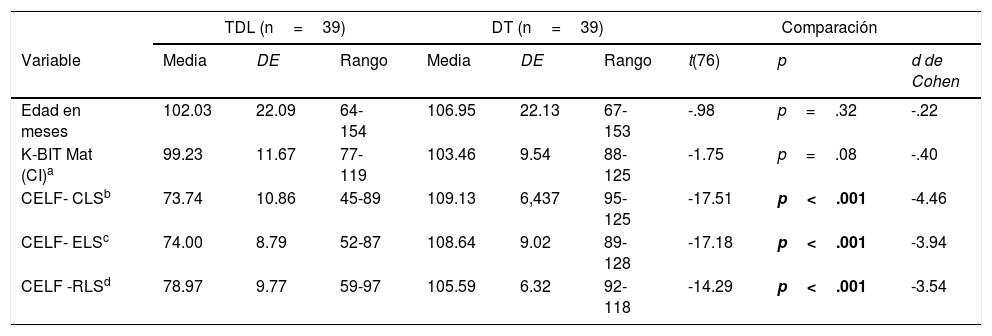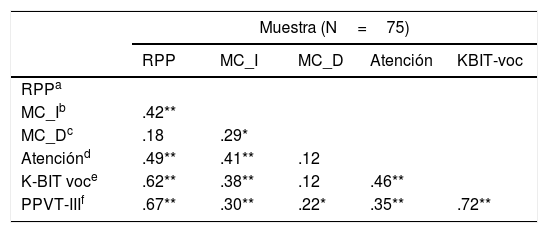Los niños y niñas con trastorno del desarrollo del lenguaje (TDL) además de las dificultades del lenguaje, también pueden tener afectados otros aspectos cognitivos como la atención y la memoria. Los estudios de estos aspectos supralingüísticos han abierto un debate en la comunidad científica y profesional para cambiar la denominación de trastorno «específico» a «trastorno del desarrollo del lenguaje». Existe un consenso sobre los déficits en la memoria fonológica, aunque hay resultados contradictorios en relación a la memoria visual y la atención. En el presente estudio evaluamos algunos aspectos de la memoria y la atención, así como el nivel de vocabulario en un grupo con TDL y un grupo con DT para conocer diferencias e interacción entre estas variables.
MétodoParticiparon 39 niños/as con TDL y 39 niños/as con DT (de 5 a 12 años) bilingües del catalán y español, emparejados por edad y sexo. Se administraron baterías de evaluación de memoria visual (inmediata/demorada), repetición de pseudopalabras, atención selectiva sostenida y un reporte familiar para evaluar inatención e hiperactividad. Aplicamos análisis lineales generalizados para comparar el rendimiento entre grupos y correlaciones con el vocabulario.
ResultadosEl grupo con TDL mostró un rendimiento inferior en todas las tareas de atención y memoria. El rendimiento de estas correlacionó positivamente con el nivel de vocabulario. El reporte familiar mostró que el número de niño/as con TDL con rasgos de inatención fue más elevado que en el grupo con DT.
ConclusionesEl diagnóstico, la intervención y la investigación del TDL tienen que considerar que las dificultades de esta población van más allá del lenguaje, y que se relacionan con déficits múltiples y variados en el desarrollo neuropsicológico.
Children with developmental language disorder (DLD) have cognitive deficit aspects such as attention and memory in addition to language difficulties. Studies of these supra-linguistic aspects have opened a debate in the scientific and professional community on changing the name of “specific” disorder to “developmental language disorder”. There is consensus about phonological memory deficits in this population but there are conflicting results in relation to visual memory and attention. In the present study we evaluated some aspects of memory and attention capacities, as well as vocabulary knowledge in a group of children with and without DLD to find differences and interaction between these variables.
Method39 bilingual Catalan-Spanish children with DLD and 39 typical developing (TD) children (from 5 to 12 years old), matched by age and sex participated in the study. Both groups were evaluated with a test battery of visual memory (immediate/delayed), non-word repetition task, sustained selective attention. A family report was used to assess inattention and hyperactivity. Linear mixed model analyses were used to compare performance between groups and correlations with vocabulary were applied.
ResultsThe group of children with DLD showed a lower performance in all attention and memory tasks. The performance of the tasks correlated positively with the level of vocabulary. The family report showed that the number of children with DLD with inattention features was higher than the number of children in the TD group.
ConclusionsDLD diagnosis, intervention and research have to consider that the difficulties of this population go beyond language, and that they are related to multiple and varied deficits in neuropsychological development.















